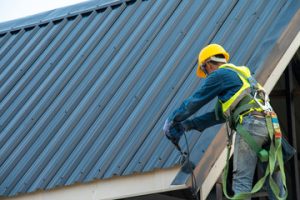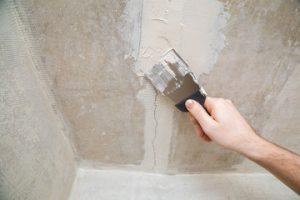Whether your roof is new or replacing an existing one, there are many considerations to make. Hiring a professional ensures the job is carried out with precision and follows best practices for durability.

Roofers lay the underlayment, then install shingles or metal panels. They also install flashing around chimneys, vents and joints to protect against water damage. Visit http://www.fivestarroofingandcontracting.com/ to learn more.
Steel is a versatile material that’s been used for centuries in construction. Its strength, durability and resistance to weather conditions make it a popular choice for commercial, industrial and residential buildings. It’s also an ideal roof material for pole barns and other types of structures with low slopes.
If your home is in an area with extreme weather conditions, a metal roof can help protect it from damage and save you money on energy bills. It is also fire-resistant and can withstand strong winds. A well-maintained metal roof can last a lifetime and requires less maintenance than an asphalt roof.
While a steel roof is more expensive than shingles, it has a much longer lifespan and may pay for itself in saved energy costs. It also offers a number of aesthetic options that can enhance the look of your home. Some styles of steel roofing are coated with solar reflectors to help reduce energy costs by reducing the amount of heat that is absorbed by your roof.
One of the best things about a steel roof is that it can withstand hail and other forms of debris that might cause damage to an asphalt shingle roof. In addition, it doesn’t attract lightning like a wooden or shingle roof might. If you live in an area with frequent thunderstorms, a steel roof can be an excellent option.
However, the upfront cost can be a deterrent for some homeowners. Many metal roofing panels are 2x, 3x or even 5x more expensive than shingles. Choosing a galvanized or aluminum-zinc coating can help offset the initial expense and extend the life of your roof.
Another disadvantage of a steel roof is that it is heavy and can require extra support when installing. It is important to use the right fasteners and have an experienced professional install your steel roof. If not properly installed, it can create a sagging roof and structural issues in your building.
While a steel roof is extremely durable, it does need periodic maintenance. A recoat every five to ten years will keep it looking new and protected for a long time. In addition, re-coating will prevent your steel roof from rusting. The new baked-on polymer coatings used on steel roofs are not only incredibly durable but will also not fade with age, unlike traditional paint.
Energy Efficiency
Energy efficiency has become a key consideration in many building projects. This is particularly true in commercial buildings, where air conditioning systems use a large amount of energy. Fortunately, there are numerous roofing solutions available that can help improve energy efficiency. Some of these are low-tech, while others incorporate solar technology into the construction.
For example, reflective roofing materials (also known as cool roofs) are designed to reflect more sunlight rather than absorb it. This can lower cooling costs and keep work spaces cooler, which in turn improves worker productivity and comfort. More advanced technologies include solar photovoltaic systems, which are integrated into the roof and can provide power to a building. This can also reduce utility costs and help a business achieve its sustainability goals.
Durability
Durability is an important aspect of roofing installation. A high-quality roof is able to resist severe weather conditions, last for a long time and provide energy efficiency. These qualities are important for a residential or commercial property owner. To determine the durability of a roofing product, it is necessary to review the manufacturer’s installation instructions and industry guidelines. This ensures that the roof is installed correctly and efficiently. During the reroofing process, it is also common for contractors to add flashing around chimneys, wood stove pipes, certain vents and along hip roofs. This helps prevent water leaks and other complications.
Safety
In addition to selecting the right roofing materials, proper roof installation requires a high level of safety. Working on a roof is dangerous and can be fatal for those who do not follow the necessary safety protocols. A reputable contractor will always ensure the work area is safe and secure. This includes blowing any leftover debris away from the house, removing anything that could fall and hurt someone, and tarping the area around plants or bushes.
Having another person available to assist and supervise is essential for a safe job site. Even if it’s just a family member, having an extra pair of hands and eyes on hand can be vital to prevent injuries from falling objects or power tools. It’s also a good idea to wear the appropriate footwear on the roof, such as non-slip shoes or boots. This will prevent you from slipping on a slippery surface and causing injury.
One of the most common causes of roofing accidents is falls from ladders or scaffolding. This can be due to a variety of reasons, such as a loose shingle, a shaky ladder or unanchored scaffolding. However, most of these falls are completely preventable with the use of proper equipment and following best practices.
When it comes to ladders, always use a safety harness system that is attached to an anchor point on the roof and secured before starting any work. Ladders should be stable and extend at least three feet above the edge of the roof. Additionally, it’s a good idea to use ladder stabilizers to prevent them from slipping.
If you’re working on a steep roof, consider using a scaffolding system. This can be a much safer option for you and your team, especially if you’re not comfortable working at heights. Additionally, be sure to check the weather forecast before beginning any work on the roof. Rain, snow or ice can make surfaces slippery and increase the risk of falls.
Once the work area is prepared, it’s time to begin laying down the shingles or tiles. Start at the bottom and work your way up, overlapping each row to prevent water infiltration. Pay special attention to the flashing around chimneys, vents and where the roof meets walls to prevent leaks. Once the shingles are installed, install gutters to channel water away from the home’s foundation.






